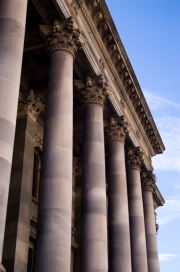09 April 2014
 In the lead up to Australian Heritage Week, University of South Australia geologist Dr Barry Cooper is asking people to take a new look at Adelaide’s premier cultural precinct North Terrace, where some of the state’s richest history is literally set in stone.
In the lead up to Australian Heritage Week, University of South Australia geologist Dr Barry Cooper is asking people to take a new look at Adelaide’s premier cultural precinct North Terrace, where some of the state’s richest history is literally set in stone.
With support from the Geological Survey of South Australia, UniSA and the Geological Society of Australia have produced a guide to the stone of North Terrace, providing a unique view of the heritage buildings, monuments and walls many Adelaide residents have passed countless times before.
From Adelaide’s oldest street statue ‘Venere di Canova’ which caused a stir when it was unveiled in 1892 to reveal a naked body, to fossil sea urchins that can be found in the walls of the South Australia Museum, the geological trail along North Terrace reveals plenty about South Australia’s stone heavy past.
“Historically, South Australia used much more stone than other states because there was limited timber available,” Dr Cooper says.
“The North Terrace precinct is particularly notable for the wide variety of stone types used, which come from all corners of the state.
“The oldest use of stone we found is in the southern perimeter wall of Government House, which was built in 1849-1850 primarily of white limestone quarried close to the site. Few people today know that stone was actually quarried in our city parklands until 1855.
“South Australia is a state rich in stone resources and much of that stone continues to be exported to overseas markets. For example, the granite paving you walk along as you pass Government House is the same stone you can find at the renowned Singapore Changi airport.
“South Australia’s famous Mintaro Slate is also found in several of the North Terrace’s most well-known buildings such as the Art Gallery of South Australia as well as city paving. Mintaro Slate is one of the oldest continuous mining operations in Australia.”
Dr Cooper, who is based at UniSA’s School of Natural and Built Environments, says the guide grew out of a field trip exercise for UniSA students.
“Strolling Adelaide’s premier walkway offered the perfect opportunity to examine the uses of stone and learn some simple geological principles,” Dr Cooper says.
“We quickly realised this exercise was not only of interest to geology students but to all city visitors who want to find out more about South Australia’s built heritage.”
The North Terrace geological trail guide can be viewed at: http://www.sa.gsa.org.au/Brochures/North_Terrace_final1.pdf
Contact for interview
Barry Cooper office 8302 5769 email barry.cooper@unisa.edu.au
Media Contact
Rosanna Galvin office (08) 8302 0578 mobile 0434 603 457 email rosanna.galvin@unisa.edu.au




